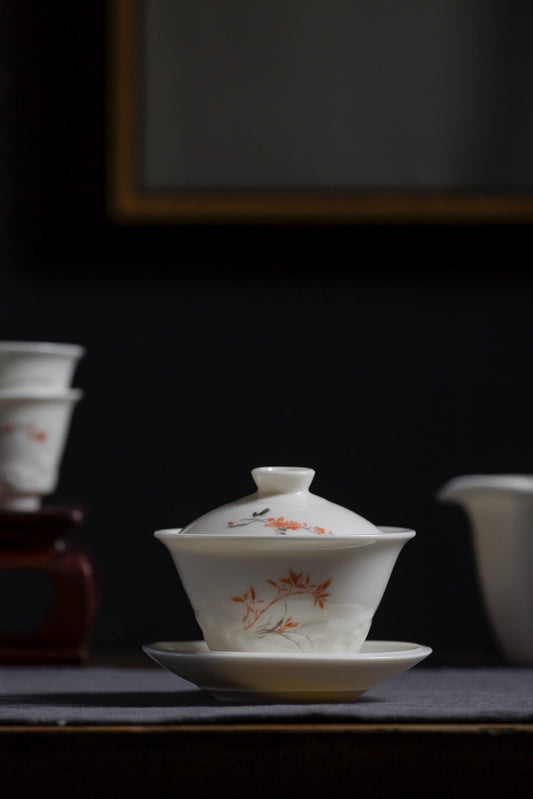Collection: Gaiwans
-
Gorgeous Fuyue Gaiwan Set
Regular price From $89.00 USDRegular price -
Ultra-thin Gaiwan Set
Regular price From $49.00 USDRegular price -
Literati Paintin Gaiwan
Regular price $199.00 USDRegular price -
Doucai Hand Painted Gaiwan
Regular price $1,600.00 USDRegular price
You would like to know
What is a Chinese Gaiwan?
A Gaiwan is a traditional tea brewing vessel used in the Gongfu tea ceremony, typically consisting of three parts: a bowl, a lid, and a saucer. Its name translates directly to "covered bowl" in Chinese. High-quality Gaiwans are usually thin-walled to facilitate quick cooling of the tea leaves when water is poured.
Gaiwans are divided into two types: those with two parts (bowl and lid) and those with three parts (bowl, lid, and saucer). Two-part Gaiwans are suitable for simpler tea brewing methods, while three-part Gaiwans are more appropriate for formal tea ceremonies. They are commonly made from porcelain, pottery, or glass, originating from the Ming Dynasty in China and sometimes referred to as Chinese teacups.
The unique shape of the Gaiwan allows it to be easily held with one hand gripping the bowl and the other hand removing the lid, facilitating tea brewing and pouring. The lid helps circulate the aroma and flavor of the tea leaves.
Uses of a Gaiwan
Gaiwans are primarily used for brewing and drinking Chinese tea, particularly in Gongfu tea ceremonies. Here are some of the main uses of a Gaiwan:
- Brewing loose leaf tea: The bowl shape and lid of the Gaiwan allow tea leaves to fully expand and circulate, releasing their aroma.
- Quick infusions: Thin porcelain or glass Gaiwans aid in rapidly cooling the tea broth, resulting in very short steeping times (10-30 seconds).
- Preserving aroma: The lid helps retain the aroma during steeping, concentrating the flavors.
- Pouring tea: After steeping, tea is poured from the Gaiwan into tasting cups.
- Cooling: Used to swiftly cool and mix tea broth to avoid oversteeping.
- Display: Brewing tea in a Gaiwan provides a visually appealing presentation of the tea leaves.
- Portioning: Small Gaiwans can hold 1-3 servings of tea, ideal for personal use.
- Convenience: Easy to handle with its built-in saucer, perfect for holding used tea leaves.
Apart from tea brewing, Gaiwans can also be used for other purposes such as:
- Jewelry holder: Organizing and displaying rings, earrings, or necklaces.
- Miniature vase: Holding fresh flowers or small branches as natural table decor.
- Candle holder: Placing small candles in the bowl to create ambiance.
- Spice dish: Keeping dried petals or spices for added visual appeal.
- Trinket tray: Displaying small collectibles like shells, stones, or antiques.
- Office organizer: Storing paperclips, pins, or rubber bands.
- Food display: Using the saucer to showcase candies, nuts, or snacks.
- Bath salt container: Keeping bath salts in the bowl with the lid to maintain dryness.
- Mini planter: Planting succulents or small plants, with the saucer catching excess water.
How to Use a Gaiwan Gracefully?
To use a Gaiwan elegantly, consider the following suggestions:
- Choose the right size: Select a Gaiwan that is large enough yet not too bulky to meet all guests' needs.
- Preheat the Gaiwan: Rinse the Gaiwan with hot water to maintain the correct brewing temperature.
- Measure tea leaves: Use 1-3 grams of tea leaves per serving, depending on the type of tea.
- Securely grip the lid: Hold the lid tightly while pouring tea to prevent slipping.
- Pour from a height: Lift your arm high and pour the tea smoothly in a fine stream.
- Pour slowly and steadily: Showcase the tea while preventing splashes.
- Gently swirl the tea: Rotate your wrist lightly while pouring to enhance tea's aeration.
- Display the Gaiwan gracefully: Place the Gaiwan in the center of the table for easy access.
- Refill gracefully: Brew the same tea leaves multiple times.
- Clean seamlessly: Prepare a waste bowl and towel for convenience.
Is a Teapot Only for Tea?
While a teapot is mainly used for brewing tea, it can also serve other purposes. For instance, it can act as a decorative piece, enhancing the aesthetic appeal of your living space. Some teapots can be used for steeping other hot beverages like herbal teas or coffee. However, this may require altering the internal structure of the teapot, which could affect its tea-brewing performance.
What to Consider When Buying a Teapot?
When buying a teapot, consider the following factors:
- Usage: What type of tea do you primarily plan to brew?— Different teas may require unique teapot designs.
- Material: What material do you want your teapot to be?— Various materials offer different insulation properties and affect the taste of the tea differently.
- Size: How large do you need the teapot to be?— A compact teapot might suffice for personal or small group use, while larger gatherings may require a bigger teapot.
- Price: What is your budget? —Teapots can range from a few dollars to several thousand, depending on factors like material, craftsmanship, and brand.
- Design: What design appeals to you? —Teapot designs range from practical simplicity to intricate complexity, each offering a unique user experience.
Interesting Tips
It's important to note that these beliefs and meanings are not universal and may vary across different cultures and historical backgrounds. However, in many traditional Chinese cultures, the Gaiwan has long been associated with good fortune and prosperity. Whether seen as a symbol of wealth, a source of relaxation, or a gift of good luck, the Gaiwan has a rich cultural history closely tied to the tradition of tea drinking in China.






